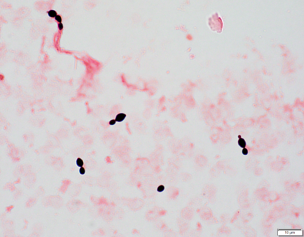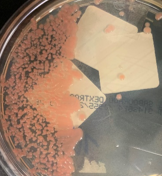1. Presented by Ankit Rajgariah, MD and reviewed by Sean Zhang, MD, PhD.
Clinical VignetteAn elderly patient presents with several weeks of nausea, decreased oral intake, and fatigue. On the day of presentation, the patient had increasing dizziness leading to a fall. Initial vitals showed that the patient was tachycardic and hypotensive. The patient was empirically treated with cefepime and metronidazole for possible sepsis. A CT chest, abdomen, and pelvis showed bilateral hydronephrosis due to obstruction from an enlarged prostate. There were several blastic bone lesions and the patient's PSA levels were increased. Overall, the findings were most consistent with metastatic prostate cancer. Given ongoing problems with hypovolemia, poor PO intake, and hypoalbuminemia, the patient was started on partial parenteral nutrition (PPN) through a peripheral line.
Two weeks into their hospitalization, the patient developed a fever and increasing white count, up to 15.01 K/cu mm (reference range: 4.50 - 11.00 K/cu mm) with 77% neutrophils, 6% bands, and 2% immature granulocytes. Blood cultures were drawn and sent for bacterial and fungal cultures. On day 4 of the blood culture, the BD BACTEC FX instrument flagged the bottle as positive, and a gram stain was performed (Figure 1).

Figure 1: Gram stain of the positive blood culture, 1000x magnification.
Laboratory StudiesThe gram stain showed budding yeast forms, which prompted further evaluation. Given the yeast forms, the PNA FISH Dual Probe assay for identification of
Candida albicans and
Candida glabrata was performed and was negative. The sample was then inoculated on a Sabouraud agar dextrose plate which showed pink, smooth, mucoid colonies (Figure 2). The organism was identified by matrix-assisted laser desorption-ionization time-of-flight mass spectrometry (MALDI-TOF MS) as
Rhodotorula mucilaginosa.
Figure 2: Sabouraud agar dextrose plate with pink, mucoid colonies.
The Sensititre YeastOne AFST custom JHH panel and Amphotericin B E Test susceptibility tests were performed. The organism had low MIC values for both Amphotericin B and 5-Flucytosine (0.5 ug/mL and 0.25 ug/mL respectively) and high MIC values for micafungin (?8 ug/mL), fluconazole (?256 ug/mL), voriconazole (?8 ug/mL), itraconazole (1 ug/mL), posaconazole (2 ug/mL), and isavuconazole (2 ug/mL).
Question:
All of the following are risk factors for
Rhodotorula mucilaginosa infection EXCEPT: